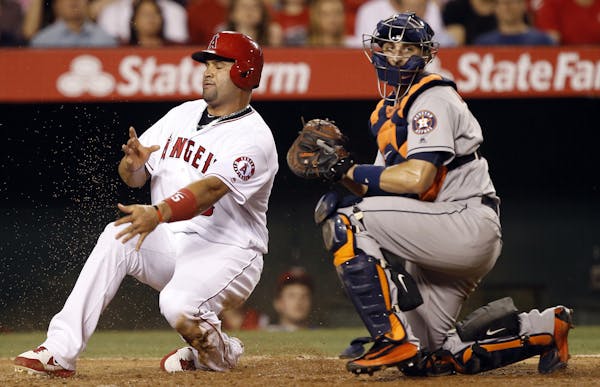The Twins' new front office began the process of improving the team's pitching staff by signing a catcher Tuesday.
Jason Castro, who played six seasons for the Houston Astros, is considered one of baseball's best pitch-framing catchers and his value to the Twins was worth a three-year contract worth $24.5 million.
But what is pitch framing and why is it valuable?
A 2014 ESPN exposé described catcher framing as "an act of subtlety, receiving the ball close to the chest, never stabbing at it, and turning pitches that nick the border of the zone -- or at least appear to -- into called strikes.
Why is it important?
The article further explains that "Though framing is an almost indiscernible art form, it is now quantifiable. Baseball Prospectus has developed metrics that measure, in essence, the extent to which catchers are responsible for the calls that go their way. When you consider how many times a good framer influences at-bats, and how many runs that can save during the course of a season, you see how truly valuable he is to his team. Now that's a great catcher."
Buster Olney, ESPN's baseball insider, wrote that the top free agent catcher on the market Matt Wieters might not be so valuable anymore because of his poor pitch-framing metrics and declining offensive production.
What makes Castro so great?
Castro had 96 more strikes called last season than what was expected, according to StatCorner.com. That was fifth-best among all catchers. He also threw out 24 percent of runners attempting to steal bases last season.
The 6-3, 215-pound catcher was an American League All-Star when he batted .276 with 18 home runs and 56 RBI in 2013. He hit just .210 last season, but his value isn't in his bat.
Castro's defense and pitch-framing metrics are why he was being pursued by several teams offering at least a three-year deal.
In 2013, Houston began putting an emphasis on pitch framing and it was reported that Castro was among the worst in the organization. However, during the past two seasons, Castro has been credited with the way he caught 2015 Cy Young Award winner Dallas Keuchel and presented his pitches "admirably."
How does Castro compare to Twins All-Star catcher Kurt Suzuki?
Suzuki had 38 less strikes called last season than what was expected, among the worst in the league according to StatCorner.com, compared to Castro's plus-96 rating.
Suzuki, a 2014 American League All-Star, threw out just 19 percent of runners attempting to steal compared to Castro's 24 percent last season.
Defensively, Castro appears to be a quality upgrade. And as Twins beat writer La Velle E. Neal pointed out, if there is a position where it's acceptable to sacrifice offense for defense, it's at catcher.
Neal added "Twins pitchers liked throwing to Suzuki and how he called games. But they should immediately benefit from Castro's moxie behind the plate. The staff's 5.08 ERA was the worst in the American League, better only than Arizona's 5.09."
Learn more about pitch framing
Mike Fast, a former Baseball Prospectus analyst that now is an analyst for the Astros, in 2011 attempted to determine what a catcher's receiving abilities were worth. A 2013 Grantland article explained "By studying where strikes are typically called and establishing which pitchers were getting more or fewer strikes than they "should" have, given where their pitches crossed the plate, Fast was able to isolate the effect of the catcher. [Fast] concluded that pitch framing can make a major impact, and it also is more consistent from year to year than even reliable offensive metrics like on-base percentage or slugging percentage. In other words, it's not insignificant, and it's not just noise. It's a valuable skill that persists from season to season."
Max Marchi at Baseball Prospectus then developed a sophisticated model for framing that took into account these factors: the umpire, the batter, the ballpark, the ball-strike count, and the pitch location and type. According to Marchi, the best receiver in the league at the time Jose Molina saved his teams 111 runs and about 11 wins because of framing from 2008 to 2013.
Twins catcher at the time Ryan Doumit was among the worst receivers and cost his teams 155 runs during this same stretch.
The Twins new brain trust made sure this won't happen for at least the next three years, according to the numbers, by quickly showing their commitment to use analytics to help improve the organization.

Wolves vs. Suns: Here are the match-ups . . . and a series prediction
Rockies' Kyle Freeland out up to 6 weeks with elbow injury. He says pitch clock may have been factor
Former Twins top draft pick Dave McCarty dead at 54
![Minnesota Twins pitcher Jhoan Duran (59) in the ninth inning Tuesday, August 15, 2023, Target Field in Minneapolis, Minn. ] CARLOS GONZALEZ • carlos](https://arc.stimg.co/startribunemedia/NWLT5CNXGTRZA6KVTMIPSOG3KI.jpg?h=91&w=145&fit=crop&bg=999&crop=faces)
Twins closer Duran could begin rehab assignment next week

